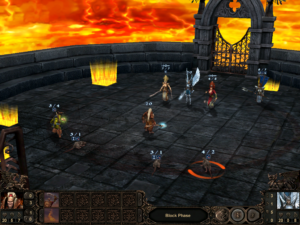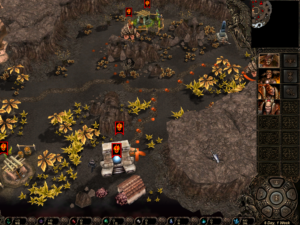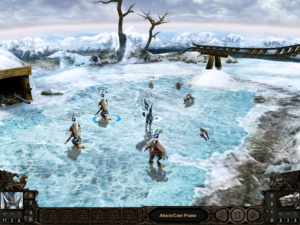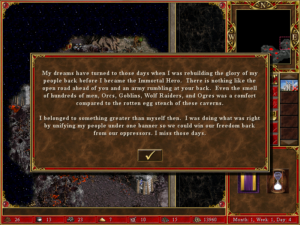Etherlords: Ethereal Combat
 Map 4 seems to be the point at which Etherlords really starts to be about non-combat spells, or, as it calls them, “Global” and “World” spells. The distinction between Global and World is unclear to me; it may have been clearer in the game’s original language (Russian, apparently). But the player starts the the scenario with a whole bunch of them, and the player pretty much has to figure out what they do by experiment, because the docs are so dismal. You can get pretty far in the level without needing any overland spells beyond the ones to summon new heroes, which are familiar by this point. I’ve explored nearly half the map by now, and only just started running into a need for more. This is because the opponent just started attacking my castle ethereally.
Map 4 seems to be the point at which Etherlords really starts to be about non-combat spells, or, as it calls them, “Global” and “World” spells. The distinction between Global and World is unclear to me; it may have been clearer in the game’s original language (Russian, apparently). But the player starts the the scenario with a whole bunch of them, and the player pretty much has to figure out what they do by experiment, because the docs are so dismal. You can get pretty far in the level without needing any overland spells beyond the ones to summon new heroes, which are familiar by this point. I’ve explored nearly half the map by now, and only just started running into a need for more. This is because the opponent just started attacking my castle ethereally.
Normal, physical attacks on castles are pretty simple: you march a hero up to a castle, and every turn that the hero is there, the castle receives an amount of damage equal to the hero’s level, possibly with a bonus from skills or magic items. Eventually either the castle’s owner manages to kill or drive away the attacker(s), or the castle is destroyed. Ethereal attacks work more or less the same way, except for the “march a hero up” part. Any hero can attack any castle ethereally, provided you have enough mana to keep the spell going. Heroes can also be assigned to ethereal defense of a castle by means of another spell. The effect is that the attacker has to defeat the defender in combat before doing any damage.
The thing is, no one actually dies in ethereal combat. Whoever wins, both heroes just go back to their bodies at the end, without even gaining any experience points from the exercise. I can imagine attacking an opponent’s castle ethereally just to keep their most powerful hero tied up defending it instead of killing your guys. In fact, that’s almost what’s happening to me: the enemy is attacking my castle with a level 6 hero, and I have one level 6 hero that I want to keep leveling up, but can I afford to? It seems like it might be a good strategy to go on a counteroffensive here, send one of my weaker heroes against his castle to see if he switches the strong guy to defending it.
Come to think of it, ethereal combat is a lot like a strategic version of what normally goes on at the tactical level. In combat mode, you basically choose every turn whether each creature under your control should attack or hang back to block attacks from the enemy. There’s no movement, no map to wander around, just a basic attack/defend option and a hero (in combat mode) or castle (in map mode) with a bunch of hit points, which it’ll lose if you don’t defend it. I wonder if this analogy was deliberate, or if the designers just felt it was the natural way to design things after they had spent so much time on M:tG-style play.
 Comments(0)
Comments(0)


